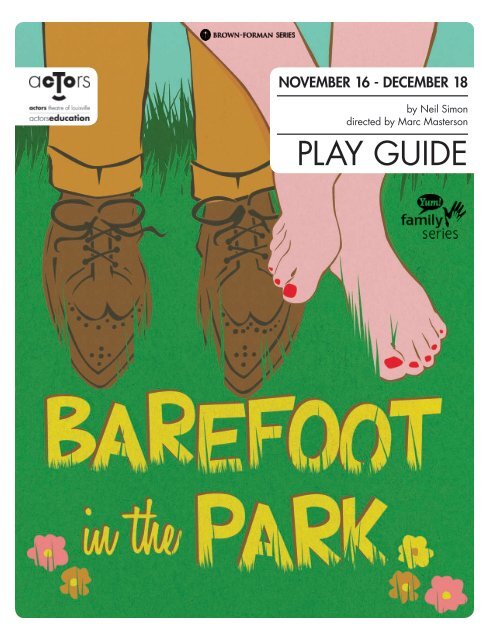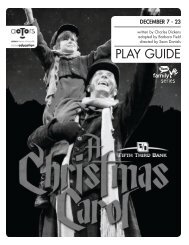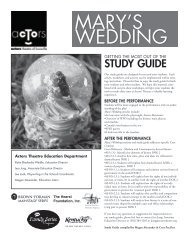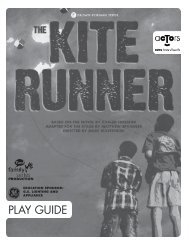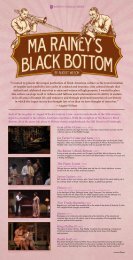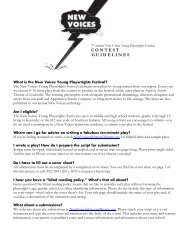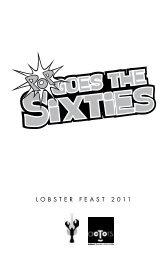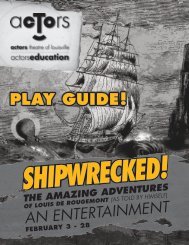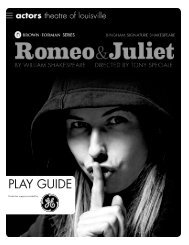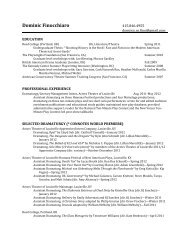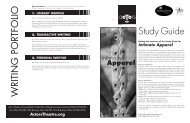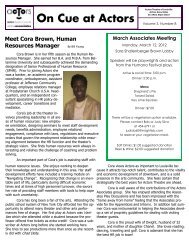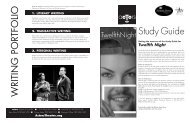Barefoot in the Park Play Guide - Actors Theatre of Louisville
Barefoot in the Park Play Guide - Actors Theatre of Louisville
Barefoot in the Park Play Guide - Actors Theatre of Louisville
You also want an ePaper? Increase the reach of your titles
YUMPU automatically turns print PDFs into web optimized ePapers that Google loves.
November 16 - December 18<br />
by Neil Simon<br />
directed by Marc Masterson<br />
PLAY GUIDE
AboUt thE<br />
BAREFOOT IN THE<br />
PARK PLAY GUIDE<br />
This play guide is a resource designed to<br />
enhance your <strong>the</strong>atre experience. Its goal<br />
is tw<strong>of</strong>old: to nurture <strong>the</strong> teach<strong>in</strong>g and<br />
learn<strong>in</strong>g <strong>of</strong> <strong>the</strong>atre arts and to encourage<br />
essential questions that lead to endur<strong>in</strong>g<br />
understand<strong>in</strong>gs <strong>of</strong> <strong>the</strong> play’s mean<strong>in</strong>g and<br />
relevance. Inside you will f<strong>in</strong>d:<br />
• Contextual and historical <strong>in</strong>formation<br />
<strong>in</strong>clud<strong>in</strong>g a list <strong>of</strong> characters, plot<br />
synopsis and <strong>in</strong>formation about <strong>the</strong><br />
playwright.<br />
• Evocative, thought provok<strong>in</strong>g articles<br />
on topics surround<strong>in</strong>g <strong>the</strong> play, which are<br />
meant to <strong>in</strong>cite conversation and analysis.<br />
• Bridgework activities<br />
connect<strong>in</strong>g <strong>the</strong>mes and ideas from <strong>the</strong><br />
play to your curriculum.<br />
• Oral discussion and writ<strong>in</strong>g prompts<br />
encourag<strong>in</strong>g your students to draw<br />
connections between <strong>the</strong> play and <strong>the</strong>ir<br />
own lives. These prompts can easily be<br />
adapted to fit most writ<strong>in</strong>g objectives.<br />
We encourage you to adapt and extend<br />
<strong>the</strong> material <strong>in</strong> any way that best<br />
fits <strong>the</strong> needs <strong>of</strong> your community <strong>of</strong><br />
learners. Please feel free to make copies<br />
<strong>of</strong> this guide, or you may download it<br />
from our website: <strong>Actors</strong><strong>Theatre</strong>.org/<br />
education_guides.htm. We hope this<br />
material, comb<strong>in</strong>ed with our pre-show<br />
workshop, will give you <strong>the</strong> tools to<br />
make your time at <strong>Actors</strong> <strong>Theatre</strong> a<br />
valuable learn<strong>in</strong>g experience.<br />
<strong>Barefoot</strong> <strong>in</strong> <strong>the</strong> <strong>Park</strong> student mat<strong>in</strong>ees<br />
and study guides address specific<br />
EduCAtiOnAl OBjECtivEs:<br />
• Students will identify or describe <strong>the</strong><br />
use <strong>of</strong> elements <strong>of</strong> drama <strong>in</strong> dramatic<br />
works.<br />
• Students will identify or expla<strong>in</strong> how<br />
drama/<strong>the</strong>atre fulfills a variety <strong>of</strong><br />
purposes.<br />
• Students will identify a variety <strong>of</strong><br />
creative dramatics.<br />
Table <strong>of</strong> conTenTs<br />
3 <strong>Barefoot</strong> <strong>in</strong> <strong>the</strong> <strong>Park</strong> Synopsis, Characters, Sett<strong>in</strong>g<br />
4 About <strong>the</strong> <strong>Play</strong>wright: Neil Simon<br />
5 <strong>Barefoot</strong> <strong>in</strong> Greenwich Village<br />
6 What Are You Laugh<strong>in</strong>g At?<br />
7 That’s Sew You!<br />
8 Tak<strong>in</strong>g a Bite Out <strong>of</strong> <strong>the</strong> Big Apple<br />
9 Discussion Questions<br />
10 Bridgework, Cross-Curricular Connections<br />
11 Writ<strong>in</strong>g Portfolio<br />
12 Works Cited<br />
<strong>Actors</strong> <strong>Theatre</strong> Education<br />
Steven Rahe, Director <strong>of</strong> Education<br />
Jacob Stoebel, Associate Director <strong>of</strong> Education<br />
Julie Mercurio, Education Fellow<br />
Jane B. Jones, Education Intern/Teach<strong>in</strong>g Artist<br />
Christ<strong>in</strong>a Lepri, Education Intern/Teach<strong>in</strong>g Artist<br />
Liz Fentress, Teach<strong>in</strong>g Artist<br />
Jessica Leader, Teach<strong>in</strong>g Artist<br />
Study guide compiled by Alex Connolly, Tara Duffy,<br />
Julie McCormick, Steven Rahe, Jacob Stoebel and<br />
Amy Wegener.<br />
Graphic design by Elissa Shortridge.<br />
The Kentucky Arts Council, <strong>the</strong><br />
state arts agency, supports <strong>Actors</strong><br />
<strong>Theatre</strong> <strong>of</strong> <strong>Louisville</strong> with state tax<br />
dollars and federal fund<strong>in</strong>g from <strong>the</strong><br />
National Endowment for <strong>the</strong> Arts.<br />
The Crawford ChariTable foundaTion<br />
supports <strong>Actors</strong> <strong>Theatre</strong> <strong>of</strong> <strong>Louisville</strong>’s 2010-2011 education programs.
synopsis<br />
Newlyweds Paul and Corie Bratter move<br />
<strong>in</strong>to a small apartment <strong>in</strong> New York<br />
City after <strong>the</strong>ir six-day honeymoon.<br />
While Paul tries to prove himself as a<br />
young lawyer <strong>in</strong> <strong>the</strong> courtroom, Corie<br />
not only sets up <strong>the</strong>ir place, she also<br />
sets up her anxious mo<strong>the</strong>r with <strong>the</strong>ir<br />
peculiar (or <strong>in</strong> Paul’s op<strong>in</strong>ion—crazy)<br />
neighbor, Mr. Velasco! After all, this<br />
is a guy who sleeps on a rug <strong>in</strong>stead <strong>of</strong><br />
a bed and enjoys some pretty bizarre<br />
cul<strong>in</strong>ary concoctions (eel knichi—<br />
gross!). Corie’s efforts to have fun and<br />
spice up Ms. Banks’ life take <strong>the</strong> four<br />
on a wild adventure all over New York<br />
City. Conventional Paul and free-spirited<br />
Corie always knew that <strong>the</strong>y were<br />
different, but after a strange night out<br />
and <strong>the</strong> events that follow, <strong>the</strong>y beg<strong>in</strong> to<br />
wonder if maybe <strong>the</strong>y are too different<br />
for one ano<strong>the</strong>r. The honeymoon might<br />
be over, but <strong>the</strong>se two young adults (and<br />
<strong>the</strong> older folks too) still have plenty to<br />
learn about <strong>the</strong>mselves and <strong>the</strong> realties<br />
and compromises that come with be<strong>in</strong>g<br />
<strong>in</strong> a relationship.<br />
- Tara Duffy<br />
casT <strong>of</strong><br />
characTers<br />
CORIE BRATTER<br />
A carefree young newlywed, busily try<strong>in</strong>g<br />
to set up and decorate <strong>the</strong> new home she<br />
shares with her husband, Paul.<br />
PAUL BRATTER<br />
Corie’s husband, a young lawyer with a dry<br />
wit who likes to stay <strong>in</strong> his comfort zone.<br />
MS. ETHEL BANKS<br />
Corie’s cautious mo<strong>the</strong>r who is will<strong>in</strong>g to<br />
endure anyth<strong>in</strong>g for her daughter, even a<br />
strange escapade around New York City.<br />
MR. VICTOR VELASCO<br />
The Bratters’ eccentric, bohemian neighbor<br />
who lives <strong>in</strong> <strong>the</strong> attic <strong>of</strong> <strong>the</strong> brownstone,<br />
just above <strong>the</strong>ir apartment.<br />
TELEPHONE MAN<br />
A good-humored man who makes<br />
observations on everyday life and<br />
relationships as he <strong>in</strong>stalls and fixes<br />
telephones.<br />
DELIVERY MAN<br />
An older man who br<strong>in</strong>gs wedd<strong>in</strong>g gifts<br />
sent to <strong>the</strong> Bratters—and is exhausted by<br />
all <strong>the</strong> flights <strong>of</strong> stairs lead<strong>in</strong>g up to <strong>the</strong><br />
apartment.<br />
seTT<strong>in</strong>g<br />
brownstone apartment build<strong>in</strong>gs<br />
PLACE The small top-floor apartment<br />
<strong>of</strong> a brownstone on East 48th Street <strong>in</strong><br />
New York City.<br />
TIME The early 1960s.<br />
CORIE: Yes, it’s five flights. If<br />
you don’t count <strong>the</strong> front stoop.<br />
TELEPHONE MAN: I<br />
counted <strong>the</strong> front stoop.<br />
Act I, Scene i<br />
3
abouT The playWrighT: neil siMon<br />
Neil Simon is widely considered one <strong>of</strong> <strong>the</strong><br />
most successful playwrights <strong>in</strong> American<br />
history. In his long and prolific career, he<br />
has become an icon <strong>of</strong> film and <strong>the</strong>atre with<br />
his dist<strong>in</strong>ctive comb<strong>in</strong>ation <strong>of</strong> humor and<br />
humanity.<br />
Simon was born to a Jewish-American<br />
family <strong>in</strong> 1927 <strong>in</strong> <strong>the</strong> Bronx, New York<br />
City. His fa<strong>the</strong>r, a garment salesman,<br />
struggled to make ends meet dur<strong>in</strong>g <strong>the</strong><br />
Great Depression. After a brief st<strong>in</strong>t <strong>in</strong><br />
<strong>the</strong> military, <strong>the</strong> young Simon teamed up<br />
with his bro<strong>the</strong>r Danny to pursue comedy<br />
writ<strong>in</strong>g <strong>in</strong> radio and television <strong>in</strong> 1948.<br />
They got <strong>the</strong>ir first break writ<strong>in</strong>g for <strong>the</strong><br />
television comedy Your Show <strong>of</strong> Shows under<br />
<strong>the</strong> actor and writer Sid Caesar. Over <strong>the</strong><br />
next few years, Caesar put toge<strong>the</strong>r writ<strong>in</strong>g<br />
teams that would make any comedy lover<br />
giddy: along with <strong>the</strong> Simons, his writers<br />
<strong>in</strong>cluded Mel Brooks, Carl Re<strong>in</strong>er, Larry<br />
Gelbart, and Woody Allen. “I knew when<br />
I walked <strong>in</strong>to Your Show <strong>of</strong> Shows,” recalled<br />
Simon, “that this was <strong>the</strong> most talented<br />
group <strong>of</strong> writers that up until that time had<br />
ever been assembled.”<br />
The experience was formative for Simon<br />
(<strong>in</strong> fact, it would serve as <strong>the</strong> <strong>in</strong>spiration<br />
for his play Laughter on <strong>the</strong> 23 rd Floor),<br />
and provides a fasc<strong>in</strong>at<strong>in</strong>g snapshot <strong>of</strong><br />
<strong>the</strong> guys who would go on to def<strong>in</strong>e<br />
American comedy <strong>in</strong> <strong>the</strong> second half <strong>of</strong><br />
<strong>the</strong> 20 th century. Like Brooks and Allen,<br />
Simon’s writ<strong>in</strong>g reflects his roots as a<br />
Jewish-American kid grow<strong>in</strong>g up <strong>in</strong> New<br />
York City. All three were sophisticated,<br />
sarcastic, and ably balanced slapstick and<br />
farce with real <strong>in</strong>sight. But <strong>in</strong> addition,<br />
Simon’s plays also capture an <strong>in</strong>clusive<br />
American experience. For him, New York<br />
seems to be a microcosm for <strong>the</strong> country<br />
as it evolved; <strong>the</strong> city was bustl<strong>in</strong>g with a<br />
diverse population <strong>of</strong> recent immigrants<br />
and represented <strong>the</strong> frontier <strong>of</strong> America’s<br />
chang<strong>in</strong>g cultural landscape.<br />
In <strong>the</strong> 1960s, Simon began writ<strong>in</strong>g for<br />
<strong>the</strong> stage. He scored a hit <strong>in</strong> 1961 with his<br />
debut, Come Blow Your Horn, which ran<br />
for 678 performances. In 1966, he made<br />
history when he had four plays runn<strong>in</strong>g<br />
simultaneously on Broadway: Sweet Charity,<br />
The Star-Spangled Girl, The Odd Couple,<br />
and <strong>Barefoot</strong> <strong>in</strong> <strong>the</strong> <strong>Park</strong> (which played<br />
for 1,530 performances). In <strong>the</strong> years<br />
that followed, he would go on to write<br />
4<br />
iconic plays and films, earn<strong>in</strong>g four Oscar<br />
nom<strong>in</strong>ations, twelve Tony nom<strong>in</strong>ations,<br />
and two Tony w<strong>in</strong>s for best play with Biloxi<br />
Blues <strong>in</strong> 1985 and Lost <strong>in</strong> Yonkers <strong>in</strong> 1991.<br />
Simon’s work has shifted over <strong>the</strong> course<br />
<strong>of</strong> his career, start<strong>in</strong>g with broad comedy<br />
but becom<strong>in</strong>g more serious-m<strong>in</strong>ded and<br />
reflective with time. Lost <strong>in</strong> Yonkers stands<br />
out as <strong>the</strong> masterpiece <strong>of</strong> his late work.<br />
Both funny and deeply sad, it shows <strong>the</strong><br />
devastat<strong>in</strong>g effect <strong>of</strong> an abusive mo<strong>the</strong>r<br />
on her grown children. In addition to <strong>the</strong><br />
Tony, <strong>the</strong> play won Simon <strong>the</strong> Pulitzer Prize<br />
for Drama.<br />
<strong>Play</strong>wright Neil Simon read<strong>in</strong>g a script <strong>in</strong> 1966<br />
Today, Simon is still writ<strong>in</strong>g new plays,<br />
even as his early work cont<strong>in</strong>ues to be<br />
revived around <strong>the</strong> country. His writ<strong>in</strong>g<br />
has been wildly successful, and is still<br />
resonant, due to his delicate balance <strong>of</strong><br />
comedy, sentiment and <strong>in</strong>sight. “I used to<br />
ask myself: What is a humorous situation?”<br />
Simon once said. “Now I ask: What is a sad<br />
situation and how can I tell it humorously?”<br />
In f<strong>in</strong>d<strong>in</strong>g humor <strong>in</strong> his characters’ troubles,<br />
he redeems what is sad and messy about<br />
<strong>the</strong>ir—and by extension, our—lives.<br />
- Alex Connolly
<strong>Barefoot</strong> <strong>in</strong> greenWich Village<br />
The neW york neighborhood ThaT changed aMerican culTure<br />
“Do you know we have some <strong>of</strong> <strong>the</strong> greatest<br />
weirdos <strong>in</strong> <strong>the</strong> country liv<strong>in</strong>g right here,<br />
<strong>in</strong> this house?” Paul says to Corie early on<br />
<strong>in</strong> <strong>Barefoot</strong> <strong>in</strong> <strong>the</strong> <strong>Park</strong>. He is referr<strong>in</strong>g to<br />
<strong>the</strong> eclectic mix <strong>of</strong> residents that <strong>in</strong>habit<br />
<strong>the</strong>ir new apartment build<strong>in</strong>g. These are<br />
unfamiliar surround<strong>in</strong>gs for <strong>the</strong> newlyweds.<br />
Paul and Corie go from <strong>the</strong>ir honeymoon at<br />
The Plaza Hotel – <strong>the</strong> epitome <strong>of</strong> high class<br />
luxury – to a cramped apartment <strong>in</strong> one <strong>of</strong><br />
New York’s edgy, emerg<strong>in</strong>g neighborhoods<br />
at a time when <strong>the</strong> culture <strong>of</strong> <strong>the</strong> city<br />
was <strong>in</strong> a state <strong>of</strong> transition: <strong>the</strong> city was a<br />
epicenter <strong>of</strong> <strong>the</strong> revolutions <strong>of</strong> <strong>the</strong> 1960s<br />
that would permanently change American<br />
culture. Nowhere was this change more<br />
visible than <strong>in</strong> Greenwich Village, where<br />
Corie first takes her shoes <strong>of</strong>f and walks<br />
barefoot through Wash<strong>in</strong>gton Square <strong>Park</strong>.<br />
“The Village” has been known throughout<br />
<strong>the</strong> 20 th century as <strong>the</strong> heartland <strong>of</strong><br />
Bohemianism, and whose impact on<br />
American culture – as captured by <strong>Barefoot</strong><br />
<strong>in</strong> <strong>the</strong> <strong>Park</strong> – has been and cont<strong>in</strong>ues to be<br />
pr<strong>of</strong>ound.<br />
Back around <strong>the</strong> 1870s, <strong>the</strong> landscape<br />
<strong>of</strong> Greenwich Village began chang<strong>in</strong>g<br />
at an accelerated pace as wealthy New<br />
Yorkers started to move north and waves<br />
<strong>of</strong> immigrants took <strong>the</strong>ir place, br<strong>in</strong>g<strong>in</strong>g<br />
with <strong>the</strong>m a rise <strong>of</strong> commercial <strong>in</strong>dustry<br />
and a radically new, dynamic culture.<br />
Immigration cont<strong>in</strong>ued to br<strong>in</strong>g <strong>in</strong> more<br />
diversity and development over <strong>the</strong> years<br />
that followed, and by <strong>the</strong> early 20 th century,<br />
The Village emerged as an enclave for artists<br />
and radicals who were attracted to its low<br />
rents and reputation for nonconformity.<br />
Off-Broadway <strong>the</strong>aters popped up, galleries<br />
provided venues for new American art,<br />
and c<strong>of</strong>fee houses became buzz<strong>in</strong>g meet<strong>in</strong>g<br />
grounds for creative young m<strong>in</strong>ds.<br />
Amid this frenzy, <strong>the</strong> American Bohemian<br />
movement emerged. Bohemianism is<br />
tricky to def<strong>in</strong>e, but its impact is visible<br />
everywhere <strong>in</strong> our lives today. Bohemians<br />
advocated “<strong>the</strong> liberated self,” a new<br />
social order <strong>in</strong> which everyone could be<br />
<strong>the</strong>mselves, free from oppressive cultural<br />
norms. In Greenwich Village, Bohemians<br />
have been on <strong>the</strong> vanguard <strong>of</strong> progressive<br />
politics. In <strong>the</strong> early 20th century, <strong>the</strong>y<br />
fought for <strong>in</strong>creased access to birth control<br />
and advocated for social justice through<br />
labor reform and revolution. Later on,<br />
Bohemianism would be associated with<br />
<strong>the</strong> beat movement <strong>of</strong> <strong>the</strong> 1950s and<br />
<strong>the</strong> cultural revolutions <strong>of</strong> <strong>the</strong> 1960s,<br />
<strong>in</strong>clud<strong>in</strong>g <strong>the</strong> anti-war, fem<strong>in</strong>ist and civil<br />
rights movements.<br />
Of course, all <strong>of</strong> this activity ga<strong>in</strong>ed a<br />
lot <strong>of</strong> attention. The Village was home<br />
to some <strong>of</strong> <strong>the</strong> century’s most famous<br />
artists, from playwright Eugene O’Neill<br />
to poet Dylan Thomas to music legend<br />
Bob Dylan. As early as <strong>the</strong> 1910s, tourists<br />
were attracted to its noted arts scene and<br />
notorious counterculture. In <strong>the</strong> 1960s,<br />
wealthier New Yorkers began mov<strong>in</strong>g<br />
<strong>in</strong>, br<strong>in</strong>g<strong>in</strong>g on a wave <strong>of</strong> gentrification<br />
that sent real estate prices soar<strong>in</strong>g. Many<br />
<strong>of</strong> <strong>the</strong> Bohemians who found a haven<br />
<strong>the</strong>re were forced to move elsewhere, and<br />
today, The Village hardly resembles its<br />
unconventional, revolutionary past.<br />
The Arch <strong>in</strong> Wash<strong>in</strong>gton Square <strong>Park</strong> is a New York icon. Photo by David Shankbone.<br />
By pitt<strong>in</strong>g <strong>the</strong> well-to-do culture <strong>of</strong> Paul<br />
and Corie’s mo<strong>the</strong>r aga<strong>in</strong>st <strong>the</strong> new<br />
bohemian radicalism <strong>of</strong> Victor Velasco,<br />
<strong>Barefoot</strong> <strong>in</strong> <strong>the</strong> <strong>Park</strong> captures – or, ra<strong>the</strong>r,<br />
caricatures – <strong>the</strong> precise moment <strong>in</strong> New<br />
York history <strong>in</strong> 1963 new and old social<br />
orders were collid<strong>in</strong>g. The foibles and<br />
friction that ensue are not just <strong>the</strong> source<br />
<strong>of</strong> one-l<strong>in</strong>ers, but also show how <strong>the</strong><br />
Bohemian movement permanently changed<br />
American culture. Thanks to <strong>the</strong> <strong>in</strong>fluence<br />
<strong>of</strong> Bohemians <strong>in</strong> <strong>the</strong> village and throughout<br />
New York, Paul, like America at large,<br />
would learn to relax, open his m<strong>in</strong>d, and<br />
every once <strong>in</strong> awhile, go barefoot <strong>in</strong> <strong>the</strong><br />
park.<br />
- Alex Connolly<br />
5
WhaT are you laugh<strong>in</strong>g aT?<br />
<strong>Theatre</strong> critic john lahr once said that “comedy is <strong>of</strong>ten relegated to <strong>the</strong> kids’ table <strong>of</strong> American<br />
<strong>the</strong>atre” because it doesn’t get all <strong>the</strong> awards and accolades that its bro<strong>the</strong>r, serious drama, receives.<br />
While comedy might not have a mantle stacked with little golden statues, and it might occasionally<br />
throw around mashed potatoes when <strong>the</strong> o<strong>the</strong>r genres aren’t look<strong>in</strong>g, that doesn’t mean it’s any less<br />
complex than drama. There are as many <strong>the</strong>ories about how comedy makes us laugh as <strong>the</strong>re are streets<br />
<strong>in</strong> <strong>the</strong> Big Apple, and <strong>the</strong>re are as many sub-genres <strong>of</strong> comedy as <strong>the</strong>re are stairs up to <strong>the</strong> Bratters’<br />
apartment. let’s break down what exactly makes us laugh <strong>in</strong> neil simon’s <strong>Barefoot</strong> <strong>in</strong> <strong>the</strong> <strong>Park</strong>.<br />
PHYsiCAl HuMOR<br />
Even before people can talk, <strong>the</strong>y laugh.<br />
Babies, strange creatures that cannot yet<br />
say a word or constantly update a Facebook<br />
status, will laugh at funny faces like an<br />
adult mak<strong>in</strong>g a cross-eyed, pucker<strong>in</strong>g<br />
expression. Even supposedly more mature<br />
people chuckle at slapstick. In <strong>Barefoot</strong><br />
<strong>in</strong> <strong>the</strong> <strong>Park</strong>, <strong>the</strong> apartment build<strong>in</strong>g itself<br />
creates moments <strong>of</strong> physical comedy. People<br />
are wheez<strong>in</strong>g after climb<strong>in</strong>g <strong>the</strong> five flights<br />
<strong>of</strong> stairs (six if you count <strong>the</strong> front stoop).<br />
The bedroom is so small that <strong>the</strong> bed barely<br />
fits and <strong>the</strong> couple has to climb over it just<br />
to get to <strong>the</strong> closet.<br />
MisundERstAnd<strong>in</strong>G<br />
Audiences like be<strong>in</strong>g smarter than <strong>the</strong><br />
characters. When we know someth<strong>in</strong>g<br />
<strong>the</strong> characters don’t, we laugh at what<br />
<strong>the</strong>se clueless people th<strong>in</strong>k is happen<strong>in</strong>g.<br />
Dramatic irony, <strong>the</strong> term for when <strong>the</strong><br />
audience knows <strong>in</strong>formation that one<br />
<strong>of</strong> <strong>the</strong> characters does not, isn’t just for<br />
Shakespearean tragedy. It happens <strong>in</strong><br />
<strong>Barefoot</strong> when Paul stops mid-sentence as<br />
he walks <strong>in</strong> to see his wife <strong>in</strong> <strong>the</strong> arms <strong>of</strong><br />
a strange Bohemian man. The audience<br />
laughs because <strong>the</strong>y saw what Paul didn’t—<br />
that Mr. Velasco is just giv<strong>in</strong>g Corie a boost<br />
so she can reach a knob that’s out <strong>of</strong> reach.<br />
It’s a classic “Wait-This-Isn’t-What-It-Looks-<br />
Like” moment.<br />
REPEtitiOn<br />
Comedy follows <strong>the</strong> same directions found<br />
on a shampoo bottle, m<strong>in</strong>us <strong>the</strong> “la<strong>the</strong>r and<br />
r<strong>in</strong>se” parts. The runn<strong>in</strong>g gag <strong>in</strong> <strong>Barefoot</strong><br />
(and this article) is all those stairs you<br />
have to climb to get to Corie and Paul’s<br />
apartment, and exactly how many <strong>the</strong>y are<br />
(five flights—or is it six?). The audience<br />
becomes familiar with <strong>the</strong> joke and starts<br />
to anticipate its appearance. Once aga<strong>in</strong>, we<br />
like feel<strong>in</strong>g smart.<br />
6<br />
comedic Genius at Work: Larry Gelbert, Woody Allen, Neil Simon, Danny Simon, mel brooks, carl re<strong>in</strong>er, and mel Tolk<strong>in</strong> writ<strong>in</strong>g for<br />
Your Show <strong>of</strong> Shows.<br />
WORd PlAY<br />
English is weird. After all, “enough” rhymes<br />
with “huff” but not with “cough.” Also,<br />
people are strange—<strong>the</strong>y <strong>of</strong>ten say what<br />
<strong>the</strong>y do not mean. Shock<strong>in</strong>g, we know. For<br />
example, Corie assures her mo<strong>the</strong>r that <strong>the</strong><br />
kitchen is big enough to make “spaghetti<br />
and th<strong>in</strong>gs.” Ms. Banks asks “What<br />
‘th<strong>in</strong>gs’?” and her daughter sarcastically<br />
responds that she makes a dish called<br />
“th<strong>in</strong>gs.”<br />
RECOGnitiOn<br />
Most successful comic characters, despite<br />
<strong>the</strong>ir eccentricities, have some basis <strong>in</strong><br />
reality. While most <strong>of</strong> Will Ferrell’s roles<br />
have a very loose connection to <strong>the</strong> real<br />
world, Neil Simon’s characters, while a bit<br />
exaggerated, are all very plausible. We all<br />
know people that play it by <strong>the</strong> book like<br />
Paul, and o<strong>the</strong>rs who just throw <strong>the</strong> book<br />
out <strong>the</strong> fifth story w<strong>in</strong>dow like Corie (or<br />
is it <strong>the</strong> sixth story?). We recognize people<br />
from our own lives, and even ourselves,<br />
<strong>in</strong> <strong>the</strong> characters onstage. We identify<br />
with <strong>the</strong>ir conflicts too, because audience<br />
members also face <strong>the</strong> dilemma <strong>of</strong> how to<br />
live <strong>the</strong>ir lives, as Corie and Paul try to<br />
figure out how to make a life toge<strong>the</strong>r.<br />
Edy<strong>the</strong> McGovern, a Simon scholar, th<strong>in</strong>ks<br />
that Neil Simon’s comedies, despite <strong>the</strong><br />
dated references to rotary phones and<br />
pocketbooks, have lasted so long because<br />
<strong>the</strong> characters are so clearly def<strong>in</strong>ed and<br />
we can easily relate to <strong>the</strong>m. At <strong>the</strong> end <strong>of</strong><br />
<strong>the</strong> day, Simon <strong>in</strong>cludes plenty <strong>of</strong> comic<br />
techniques <strong>in</strong> his play, but <strong>the</strong> subject<br />
matter—just how funny and strange people<br />
can be—is at <strong>the</strong> root <strong>of</strong> all <strong>the</strong> laughs.<br />
- Tara Duffy
ThaT’s seW you!<br />
an <strong>in</strong>TerVieW WiTh lorra<strong>in</strong>e Venberg<br />
As <strong>the</strong> Resident Costume designer for <strong>Actors</strong><br />
<strong>Theatre</strong> <strong>of</strong> louisville, lorra<strong>in</strong>e venberg has<br />
dressed plenty <strong>of</strong> productions, and is currently<br />
work<strong>in</strong>g on <strong>Barefoot</strong> <strong>in</strong> <strong>the</strong> <strong>Park</strong>. she recently<br />
answered questions about what exactly it takes<br />
to clo<strong>the</strong> an entire cast from head to toe. Heads<br />
up—it’s more than just sew<strong>in</strong>g quickly, and<br />
research is not just someth<strong>in</strong>g you do for term<br />
papers. F<strong>in</strong>d out how costumes help def<strong>in</strong>e time,<br />
place and characters <strong>in</strong> neil simon’s comedy.<br />
First Lady Jackie Kennedy was an icon <strong>of</strong> conservative, early 1960s fashion with her chanel suit<br />
and pillbox hat<br />
Where do you beg<strong>in</strong> when design<strong>in</strong>g costumes<br />
for a production?<br />
The first step is, obviously, read<strong>in</strong>g <strong>the</strong> play. I like to read <strong>the</strong><br />
play for enjoyment <strong>the</strong> first time, and <strong>the</strong>n read it aga<strong>in</strong> to look<br />
for any costume <strong>in</strong>formation. Then I start research<strong>in</strong>g <strong>the</strong> era <strong>of</strong><br />
<strong>the</strong> production. <strong>Barefoot</strong> <strong>in</strong> <strong>the</strong> <strong>Park</strong> takes place <strong>in</strong> <strong>the</strong> early 1960s,<br />
and it’s <strong>in</strong> New York City, not <strong>the</strong> middle <strong>of</strong> Nebraska. It’s not like<br />
<strong>the</strong>y’re all walk<strong>in</strong>g out <strong>of</strong> Vogue magaz<strong>in</strong>e, <strong>the</strong>y’re still real people,<br />
but <strong>the</strong>re is a different level <strong>of</strong> style for people liv<strong>in</strong>g <strong>in</strong> New York.<br />
How do you research what people wore more<br />
than forty years ago?<br />
The Internet, <strong>of</strong> course, is great. For <strong>the</strong> delivery man, I might try<br />
to look up old newspaper ads that have happy delivery men from<br />
Macy’s or such. I used to spend a lot <strong>of</strong> hours <strong>in</strong> libraries and photo<br />
collections. The Internet makes it very easy, but it’s still a search.<br />
It’s not like you can type <strong>in</strong> “New York City Department Store<br />
Delivery Man 1964,” and have someth<strong>in</strong>g come up. You still have<br />
to do some search<strong>in</strong>g, and make sure <strong>the</strong> source is reliable.<br />
How do you turn all that <strong>in</strong>formation and images<br />
<strong>in</strong>to tangible garments that people can wear?<br />
After I ga<strong>the</strong>r all that <strong>in</strong>formation, I start do<strong>in</strong>g draw<strong>in</strong>gs. I tend to<br />
do just pencil draw<strong>in</strong>gs to beg<strong>in</strong> with and <strong>the</strong>n go to <strong>the</strong> director<br />
and talk about <strong>the</strong> draw<strong>in</strong>gs and make revisions. Then I create color<br />
render<strong>in</strong>gs.<br />
Then we ei<strong>the</strong>r make or buy <strong>the</strong> clo<strong>the</strong>s. With <strong>Barefoot</strong>, you <strong>of</strong>ten<br />
can f<strong>in</strong>d 1960s clo<strong>the</strong>s <strong>in</strong> v<strong>in</strong>tage stores or on eBay. But if you are<br />
walk<strong>in</strong>g <strong>in</strong>to a v<strong>in</strong>tage store, you just pray, because you can f<strong>in</strong>d <strong>the</strong><br />
perfect suit but it might be <strong>the</strong> wrong size. Sometimes I will still<br />
purchase <strong>the</strong> garment so someone <strong>in</strong> <strong>the</strong> costume shop can copy <strong>the</strong><br />
pattern <strong>in</strong>to <strong>the</strong> right size.<br />
Then we shop for fabrics for <strong>the</strong> pieces we need to construct, and<br />
for shoes and accessories—everyth<strong>in</strong>g for <strong>the</strong> complete look <strong>of</strong> a<br />
character. If it’s a purchased garment, we have fitt<strong>in</strong>gs with <strong>the</strong><br />
actors and <strong>the</strong>n alterations. If we have to build someth<strong>in</strong>g from<br />
scratch, we make it <strong>in</strong> musl<strong>in</strong> first, and <strong>the</strong>n have <strong>the</strong> actors come<br />
<strong>in</strong> for fitt<strong>in</strong>gs. We do all <strong>the</strong> adjustments on <strong>the</strong> mock-up before<br />
we cut <strong>in</strong>to <strong>the</strong> expensive fabric. And <strong>the</strong>n <strong>the</strong> costumes are ready<br />
for <strong>the</strong> show.<br />
so o<strong>the</strong>r than mak<strong>in</strong>g sure no one is naked<br />
onstage, why are costumes important? How do<br />
<strong>the</strong>y help to tell <strong>the</strong> story <strong>of</strong> <strong>the</strong> play?<br />
Through <strong>the</strong> style l<strong>in</strong>es, colors and fabrics, we can highlight <strong>the</strong><br />
different personalities <strong>of</strong> <strong>the</strong>se characters. Paul’s a lawyer, and<br />
lawyers almost always have <strong>the</strong> uniform <strong>of</strong> <strong>the</strong> conservative suit and<br />
tie. He’s not go<strong>in</strong>g to be wear<strong>in</strong>g some wacky 1960s th<strong>in</strong>g, like a<br />
bold scarf. But <strong>the</strong>n <strong>the</strong>re is Victor, <strong>the</strong> guy liv<strong>in</strong>g upstairs, who is<br />
wacky. Maybe he’s <strong>the</strong> one wear<strong>in</strong>g <strong>the</strong> colorful scarf and bright<br />
pants. How <strong>the</strong>se characters dress re<strong>in</strong>forces <strong>the</strong> differences <strong>in</strong> <strong>the</strong>ir<br />
personalities.<br />
- Tara Duffy<br />
7
Tak<strong>in</strong>g a biTe ouT <strong>of</strong> The big apple:<br />
The geography <strong>of</strong> <strong>Barefoot</strong> <strong>in</strong> <strong>the</strong> <strong>Park</strong><br />
new jersey This state<br />
borders New York City<br />
to <strong>the</strong> east and south.<br />
Although it’s known for<br />
its large Italian-American<br />
population and is <strong>of</strong>ten<br />
stereotyped as highly<br />
<strong>in</strong>dustrial, New Jersey is a<br />
diverse state that <strong>in</strong>cludes<br />
affluent suburbs to <strong>the</strong><br />
east <strong>of</strong> Manhattan, where<br />
Corie’s mo<strong>the</strong>r lives.<br />
8<br />
Wash<strong>in</strong>gton square <strong>Park</strong><br />
This public park is one <strong>of</strong> nearly<br />
2,000 <strong>in</strong> New York City. Located <strong>in</strong><br />
Greenwich Village, this park is known<br />
as a meet<strong>in</strong>g place for students (New<br />
York University is nearby) and visual,<br />
musical and performance artists<br />
who live <strong>in</strong> and around <strong>the</strong> eclectic<br />
neighborhood.<br />
Manhattan The borough that<br />
Corie and Paul call home and one<br />
<strong>of</strong> <strong>the</strong> largest cultural, commercial<br />
and f<strong>in</strong>ancial centers <strong>in</strong> <strong>the</strong> world.<br />
Many iconic skyscrapers <strong>in</strong> <strong>the</strong> area<br />
house <strong>in</strong>ternational corporations.<br />
Wall Street, <strong>the</strong> f<strong>in</strong>ancial heartbeat<br />
<strong>of</strong> <strong>the</strong> global economy, is <strong>in</strong> lower<br />
Manhattan, while fur<strong>the</strong>r north<br />
<strong>in</strong> Midtown Manhattan resides<br />
<strong>the</strong> United Nations Headquarters.<br />
The newlyweds live <strong>in</strong> a section <strong>of</strong><br />
Midtown where young pr<strong>of</strong>essionals<br />
and eccentric artists meet.<br />
Brooklyn<br />
staten island This sou<strong>the</strong>rnmost borough <strong>of</strong> New York City is also its<br />
most suburban and least populated—a quarter <strong>of</strong> a million people dur<strong>in</strong>g <strong>the</strong><br />
1960s. To get <strong>the</strong>re from Manhattan you ei<strong>the</strong>r have to take a half-hour ferry<br />
trip across Upper New York Bay or travel to Brooklyn, <strong>the</strong> borough sou<strong>the</strong>ast<br />
<strong>of</strong> Manhattan, and <strong>the</strong>n drive across <strong>the</strong> Verrazano-Narrows Bridge—and<br />
consider<strong>in</strong>g New York traffic, that might take a while!<br />
Westchester E<strong>the</strong>l Banks, Corie’s mo<strong>the</strong>r,<br />
has lunch <strong>in</strong> this New York county known<br />
for its wealthy suburbs north <strong>of</strong> <strong>the</strong> Bronx,<br />
<strong>the</strong> nor<strong>the</strong>rnmost borough <strong>of</strong> New York City.<br />
Afterwards, she stops by Corie and Paul’s<br />
apartment, claim<strong>in</strong>g it was just on her way<br />
back home to New Jersey. Seems like she’s<br />
tak<strong>in</strong>g a ra<strong>the</strong>r long way back, doesn’t it?<br />
Bronx<br />
Queens Thanks to <strong>the</strong><br />
highway layout, E<strong>the</strong>l must pass<br />
through this borough when she<br />
checks <strong>in</strong> on <strong>the</strong> newlyweds.<br />
Known for its numerous<br />
immigrant neighborhoods,<br />
Queens was home to large<br />
Italian, Irish, Greek, Lat<strong>in</strong>o<br />
and South Asian populations,<br />
and is <strong>the</strong> easternmost borough<br />
<strong>of</strong> New York City, located on<br />
Long Island.<br />
- Tara Duffy
discussion QuesTions<br />
pre-shoW<br />
1. Do you really th<strong>in</strong>k that opposites<br />
attract <strong>in</strong> romantic and platonic<br />
relationships? Why or why not?<br />
2. Have you ever been caught <strong>in</strong> <strong>the</strong><br />
middle <strong>of</strong> a couple or two friends hav<strong>in</strong>g<br />
a fight? Were you uncomfortable? Did<br />
you th<strong>in</strong>k that just one person was <strong>in</strong><br />
<strong>the</strong> wrong, or both? Did you try to <strong>of</strong>fer<br />
advice or did you pretend like noth<strong>in</strong>g<br />
was go<strong>in</strong>g on? Why?<br />
3. Have you ever had a friend who doesn’t<br />
th<strong>in</strong>k th<strong>in</strong>gs through? What about a<br />
friend who th<strong>in</strong>ks too much and overanalyzes<br />
everyth<strong>in</strong>g? Where do you<br />
th<strong>in</strong>k you fall <strong>in</strong> <strong>the</strong> spectrum?<br />
posT-shoW<br />
1. <strong>Barefoot</strong> <strong>in</strong> <strong>the</strong> <strong>Park</strong> is set <strong>in</strong> <strong>the</strong> early<br />
1960s. Do you th<strong>in</strong>k <strong>the</strong>re are any<br />
parts <strong>of</strong> <strong>the</strong> play that are dated? What<br />
rema<strong>in</strong>s <strong>the</strong> same <strong>in</strong> 2010? Would you<br />
contemporize <strong>the</strong> play if given <strong>the</strong><br />
chance, or keep it set <strong>in</strong> that era? If so,<br />
how? And if not, why not?<br />
2. You saw <strong>Barefoot</strong> <strong>in</strong> <strong>the</strong> <strong>Park</strong> performed<br />
<strong>in</strong> <strong>the</strong> B<strong>in</strong>gham <strong>Theatre</strong>—a <strong>the</strong>atre<br />
<strong>in</strong> <strong>the</strong> round. What are some <strong>of</strong> <strong>the</strong><br />
challenges <strong>of</strong> this type <strong>of</strong> set up? How<br />
did this production overcome <strong>the</strong>se<br />
obstacles?<br />
3. <strong>Barefoot</strong> <strong>in</strong> <strong>the</strong> <strong>Park</strong> is largely about<br />
<strong>the</strong> marriage <strong>of</strong> Corie and Paul. What<br />
are some <strong>of</strong> <strong>the</strong> ways <strong>the</strong> characters<br />
portrayed <strong>the</strong>ir affection for each<br />
o<strong>the</strong>r? Their displeasure? How is that<br />
different from <strong>the</strong> way <strong>the</strong>y <strong>in</strong>teracted<br />
with <strong>the</strong> o<strong>the</strong>r characters <strong>of</strong> <strong>the</strong> play?<br />
Th<strong>in</strong>k specifically about what <strong>the</strong><br />
actors physically did to act like young<br />
newlyweds.<br />
The <strong>in</strong>tersection <strong>of</strong> 49 nd St. and Fifth Ave <strong>in</strong> 1968<br />
9
idgeWork<br />
aT your desk<br />
1. At <strong>the</strong> start <strong>of</strong> <strong>the</strong> play, Corie is very excited about decorat<strong>in</strong>g<br />
<strong>the</strong> new apartment that she and Paul now share. Draw what<br />
your dream apartment would look like. Share with <strong>the</strong> class why<br />
you picked <strong>the</strong> colors, furniture, etc., that you did.<br />
2. Pretend that are you are a marriage counselor and Paul and<br />
Corie have just come to see you. Write a paragraph <strong>of</strong> advice<br />
that you would give <strong>the</strong> newlyweds. Share with <strong>the</strong> class.<br />
The poster to <strong>the</strong> 1967 film adaptation <strong>of</strong> barefoot <strong>in</strong> <strong>the</strong> <strong>Park</strong><br />
cross-curricular connecTions<br />
Music<br />
Music is not only <strong>in</strong>dicative <strong>of</strong> a certa<strong>in</strong> time period, it’s also a way<br />
that people def<strong>in</strong>e <strong>the</strong>mselves. Research songs that were popular<br />
<strong>in</strong> <strong>the</strong> first half <strong>of</strong> <strong>the</strong> 1960s and <strong>the</strong>n create a playlist for one <strong>of</strong><br />
<strong>the</strong> characters. Write a paragraph expla<strong>in</strong><strong>in</strong>g why you th<strong>in</strong>k your<br />
character, whe<strong>the</strong>r it’s Paul or Mr. Velasco, would enjoy listen<strong>in</strong>g to<br />
<strong>the</strong>se tunes.<br />
arT<br />
Greenwich Village, where <strong>Barefoot</strong> <strong>in</strong> <strong>the</strong> <strong>Park</strong> is located, was<br />
and still is <strong>the</strong> home for many renowned (albeit eccentric) artists.<br />
Research artists who have lived <strong>in</strong> <strong>the</strong> Village and create a slideshow<br />
or poster that features photos <strong>of</strong> <strong>the</strong>ir works and explanations<br />
<strong>of</strong> how <strong>the</strong>ir pieces changed <strong>the</strong> art world. Which characters <strong>in</strong><br />
<strong>Barefoot</strong> would like which piece <strong>of</strong> art? Do you th<strong>in</strong>k any <strong>of</strong> <strong>the</strong><br />
works would fit <strong>in</strong> at <strong>the</strong> Bratters’ apartment?<br />
10<br />
on your feeT<br />
1. In <strong>Barefoot</strong>, Corie is always ready to just go with <strong>the</strong> flow even<br />
if it seems a bit silly to Paul. Practice be<strong>in</strong>g as accept<strong>in</strong>g as<br />
Corie by play<strong>in</strong>g <strong>the</strong> “Yes Let’s” improv game. One player starts,<br />
say<strong>in</strong>g “Let’s ...” fill<strong>in</strong>g <strong>in</strong> what he or she wants to do. Then<br />
<strong>the</strong> entire group responds “Yes Let’s!” and starts do<strong>in</strong>g what<br />
<strong>the</strong> player described. Then a different player makes a different<br />
suggestion and <strong>the</strong> process happens all over aga<strong>in</strong>. Cont<strong>in</strong>ue<br />
until everyone <strong>in</strong> <strong>the</strong> room has made a suggestion. Make sure<br />
that <strong>the</strong> suggestions don’t repeat and are physically possible and<br />
safe <strong>in</strong> <strong>the</strong> space you are work<strong>in</strong>g <strong>in</strong>. Remember, <strong>the</strong> ma<strong>in</strong><br />
objective for this game is for everyone to work toge<strong>the</strong>r to have<br />
fun!<br />
2. <strong>Barefoot</strong> is all about character contrasts—so create your own<br />
character based on <strong>the</strong> opposite <strong>of</strong> yourself. Walk around <strong>the</strong><br />
room <strong>in</strong> silence. How <strong>the</strong>y would classify yourself?<br />
• loud or quiet<br />
• worry<strong>in</strong>g or carefree<br />
• strong or weak<br />
• tall or small<br />
• secure or <strong>in</strong>secure<br />
• clumsy or graceful<br />
• happy or sad<br />
• outgo<strong>in</strong>g or shy<br />
Imag<strong>in</strong>e you are exactly <strong>the</strong> opposite <strong>of</strong> all <strong>the</strong>se character traits.<br />
Remember that different doesn’t always mean opposite, so make<br />
sure you go to <strong>the</strong> o<strong>the</strong>r extreme <strong>of</strong> <strong>the</strong> spectrum. How would<br />
you move as this character who has completely opposite traits<br />
from yourself? After a few moments, beg<strong>in</strong> to speak and <strong>in</strong>teract<br />
with <strong>the</strong> o<strong>the</strong>r characters <strong>in</strong> <strong>the</strong> room.<br />
hisTory<br />
There were a lot <strong>of</strong> transformative events happen<strong>in</strong>g <strong>in</strong> New York<br />
City just before and dur<strong>in</strong>g <strong>the</strong> time that <strong>Barefoot</strong> <strong>in</strong> <strong>the</strong> <strong>Park</strong> takes<br />
place, moments that would forever shape <strong>the</strong> city. Research and<br />
create a timel<strong>in</strong>e <strong>of</strong> some major events <strong>in</strong> New York City history,<br />
start<strong>in</strong>g from <strong>the</strong> end <strong>of</strong> War World II to 1965. How did <strong>the</strong> city,<br />
and even <strong>the</strong> entire country, change as a result <strong>of</strong> <strong>the</strong>se events? Do<br />
you see any evidence <strong>of</strong> <strong>the</strong>se events <strong>in</strong> <strong>Barefoot</strong>?
WriT<strong>in</strong>g porTfolio<br />
A NYc apartment build<strong>in</strong>g <strong>in</strong> <strong>the</strong> 1960s<br />
personal<br />
In <strong>Barefoot</strong>, many <strong>of</strong> <strong>the</strong> characters have<br />
to step outside <strong>of</strong> <strong>the</strong>ir comfort zones.<br />
Write a personal narrative about a time a<br />
friend or mentor pushed you out <strong>of</strong> your<br />
rout<strong>in</strong>e. Describe <strong>the</strong> circumstances. Were<br />
you will<strong>in</strong>g to go with <strong>the</strong> flow or did you<br />
resist it? In retrospect, are you glad you put<br />
yourself out <strong>the</strong>re, or do you regret it? What<br />
did you learn from <strong>the</strong> whole experience?<br />
liTerary<br />
<strong>Barefoot</strong> <strong>in</strong> <strong>the</strong> <strong>Park</strong> is set <strong>in</strong> New York<br />
City, and mentions various neighborhoods,<br />
streets, parks and landmarks <strong>in</strong> <strong>the</strong> Big<br />
Apple. Write a short story where characters<br />
have to travel from one end <strong>of</strong> New<br />
York City to <strong>the</strong> opposite end—just like<br />
what happened when Mr. Velasco takes<br />
<strong>the</strong> Bratters and Mo<strong>the</strong>r out to Staten<br />
Island. The short story should feature<br />
neighborhoods, streets, and attractions,<br />
although <strong>the</strong>y can be different from <strong>the</strong><br />
ones used <strong>in</strong> <strong>Barefoot</strong>. It is up to you to<br />
create <strong>the</strong> characters and <strong>the</strong> reason why<br />
<strong>the</strong>y have to go across town!<br />
TransacTiVe<br />
Write a review <strong>of</strong> <strong>the</strong> performance <strong>of</strong><br />
<strong>Barefoot</strong> <strong>in</strong> <strong>the</strong> <strong>Park</strong> that you saw at <strong>Actors</strong><br />
<strong>Theatre</strong> <strong>of</strong> <strong>Louisville</strong>. Describe what it was<br />
like to watch <strong>the</strong> play, but be sure to write<br />
more than just <strong>the</strong> plot <strong>of</strong> <strong>the</strong> play. Th<strong>in</strong>k<br />
about how <strong>the</strong> play tells <strong>the</strong> story. Make<br />
<strong>the</strong> experience come alive for <strong>the</strong> reader by<br />
us<strong>in</strong>g lots <strong>of</strong> sensory details when writ<strong>in</strong>g<br />
about several <strong>of</strong> <strong>the</strong> play’s elements, like<br />
<strong>the</strong> costumes, lights, props, music, how <strong>the</strong><br />
actors said <strong>the</strong>ir l<strong>in</strong>es, and how <strong>the</strong> director<br />
realized <strong>the</strong> vision <strong>of</strong> <strong>the</strong> play. Let <strong>the</strong><br />
audience decide for <strong>the</strong>mselves if <strong>the</strong> play is<br />
worth see<strong>in</strong>g.<br />
11
Works ciTed<br />
“About Neil Simon.” PBS American Masters. PBS. 3 Nov. 2000. Web. 10 July 2010.<br />
Flowers, Charles. “Simon says: At work and at play with Neil Simon.” BookPage. BookPage,<br />
Oct. 1999. Web. 12 July 2010.<br />
Lahr, John. “Master <strong>of</strong> Revels.” New Yorker, 86.11 (2010): 70-76. Pr<strong>in</strong>t.<br />
McGovern, Edy<strong>the</strong>. Not-So-Simple Neil Simon: A Critical Study. Van Nuys, CA: Perivale<br />
Press, 1978. Pr<strong>in</strong>t.<br />
Roberts, Rex. “When Greenwich Village was a Bohemian paradise.” Insight on <strong>the</strong> News.<br />
BNET. 29 July 2002. Web. 25 June 2010.<br />
Simon, Neil. The <strong>Play</strong> Goes On: A Memoir. NY: Simon & Schuster, 1999. Pr<strong>in</strong>t.<br />
“Village History.” The Greenwich Village Society for Historic Preservation. The Greenwich<br />
Village Society for Historic Preservation, 2010. Web. 25 June 2010.<br />
if you liked<br />
<strong>Barefoot</strong> <strong>in</strong> <strong>the</strong> <strong>Park</strong>...<br />
plays<br />
The Odd Couple by Neil Simon<br />
Brighton Beach Memoirs by Neil Simon<br />
The Producers by Mel Brooks and Thomas Meehan<br />
books<br />
Greenwich Village: Culture and Counterculture by Rick Beard, Leslie<br />
Berlowitz, and <strong>the</strong> Museum <strong>of</strong> <strong>the</strong> City <strong>of</strong> New York<br />
New York: An Illustrated History by Ric Burns, James Sanders, and Lisa Ades<br />
The 1960s by Edward J. Reilly<br />
Rewrites: A Memoir (1996) by Neil Simon<br />
The <strong>Play</strong> Goes on: A Memoir (1999) by Neil Simon<br />
filM<br />
<strong>Barefoot</strong> <strong>in</strong> <strong>the</strong> <strong>Park</strong> (1967) dir. Gene Saks<br />
Murder by Death (1976) written by Neil Simon<br />
Laughter on <strong>the</strong> 23rd Floor (2001) written by Neil Simon<br />
TV<br />
Mad Men, AMC, Sundays at 10 PM


